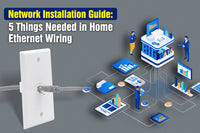Contents
The development of big data results in an increase in computing and cloud demands. So more and more data centers and server rooms are needed for IT infrastructures. Server racks or cabinets are vital in your data center, just like the foundation of building a house and they make it possible to make your IT hardware organized and neat. Here is everything you need to know about server racks before you equip your data center or server room.
What Is a Server Rack?
Server racks can also be named as LAN racks or network racks. A server rack or network cabinet is designed to accommodate different technical devices, including routers, network switches, hubs, Ethernet cables, patch panels, and other storage devices. A server rack can help well fix many necessary devices into their position to ensure a stable operation. Server racks or cabinets are widely used in businesses and are often located in data centers or server rooms.
Types of Server Racks: Server Rack or Cabinet?
Server racks come in different types and sizes and can also be customized. There are three primary server racks: open server racks, server rack cabinets, and wall-mount racks. Let’s dive into these types.
Open Server Rack
Open server racks only feature open frames without sides or doors. These racks feature an open structure for mounting IT equipment. Open server racks also come in different sizes and can hold many network equipment. These open-frame racks are generally used for server rooms or data centers that don’t require physical security. They provide enough space for other IT equipment but should be located beside the wall to keep them stable.
Open server racks can generally be divided into two types: 2 post or 4 post types (Post means the vertical rack rail). 2-post open server racks require less space than 4-post ones but can support less weight.

Server Rack Cabinet
Server rack cabinets feature front and rear doors and side panels, and the front doors can be locked to provide better physical security. Keeping devices cool is essential for the best performance in the data center, and server rack cabinets can be the best choice. The design of server rack cabinets is optimized to allow for airflow. The server rack cabinet can also be equipped with a cooling system according to your own requirement.

Wall-Mount Rack
As the name explains, wall-mount racks are usually made to be attached to the wall. They can be open-frame racks or rack cabinets but are smaller than other standard racks. So, these wall-mount racks can save more space but support less weight. Wall-mount racks are widely used in different scenarios, including classrooms, offices, and telecom rooms.

Server Rack Sizes
Server racks come in different sizes, and choosing the correct size could be challenging, especially when you know little about them. Understanding the variables helps you find the best server rack.
Server Rack Height
Server rack height is the main factor that divides racks into different sizes. People often mention racks by their height and you can see 42U or 48U racks on the market. Do you know the meaning of “U”? “U” refers to “rack units,” and it is equal to 1.75 inches. The height of server racks in the data centers or server rooms is always 42U, 45U, or 48U for their large size. If used in high-density environments, the server rack height can be customized to 58U.
Server Rack Depth
The rack depth is also essential to hold your equipment. Server rack depth is measured in inches, varying from 0 to 50 inches. The most common depth on the market is 24 inches and 48 inches. The extra depth allows the server rack to hold cable management like patch panels and more accessories. A server rack should be deep enough to accommodate network switches from Dell and Cisco. In general, a wall mount rack can be shallow to save space.
Server Rack Width
A server rack with 19-inch width is very common in the industry because many servers and patch panels also have a width of 19 inches. So you don’t need to worry about choosing the correct server width. But it would help if you considered the exterior width. The standard exterior width of the server rack cabinet is 24 inches. Extra-wide server racks are also available to easily accommodate different IT equipment, including power distribution units (PDUs) and cabling devices with enough airflow.
So, how to choose the correct size when considering the installation? In general, smaller or wall-mount racks are suitable for home or office rack installation; while 4-post racks or enclosed server racks are greater for data centers or server rooms. Of course, it all depends on your own needs.
Benefits of Server Racks
Server racks are a cost-effective and efficient solution for data centers and they offer many benefits for businesses that require data centers or server rooms:
- Cabling Management: Overwhelmed by the cable clutters or tangled cables? The server rack is the best solution. Server racks make it easy to manage the server and other accessories, such as patch panels and cable managers. It helps keep cables in place, allowing for neat and organized cable management.
- Security: The network cabinet is usually made of metal, and the door often features a locking mechanism, helping to reduce incidents and protect data on the server.
- Cooling: The server rack is designed to optimize airflow and cooling, which can help prevent the overheating of the server.
- Space-Saving: The server rack can accommodate the server system’s related hardware in a compact size, which can minimize the use of floor space. For those large-scale data centers, server racks can also be organized side by side.
- Flexibility: Server racks are scalable, so businesses can add or remove servers based on their own requirements.
Other Accessories
Server racks can hold various hardware, including PDUs, network switches, patch panels, keystone jacks, and other IT hardware.
- Network Switch: Standard server racks can accommodate switches from Cisco, Dell, and Netgear.
- Patch Panel: They can also hold different kinds of patch panels including blank, punch down, and feed-through patch panels.
- Ethernet Keystone Jack: There are also keystone jacks designed for data centers and server rooms. These colorful keystone jacks help organize different cables with color coding, allowing for easy cable management.

For more information on this topic, you can keep up on our blogs. While VCELINK offers general and basic information for our customers and other visitors to the website, it’s not professional advice.





such an informative article regarding racks and its use in offices and information regarding sizes, materials, and their utilization at different places in very well explained.